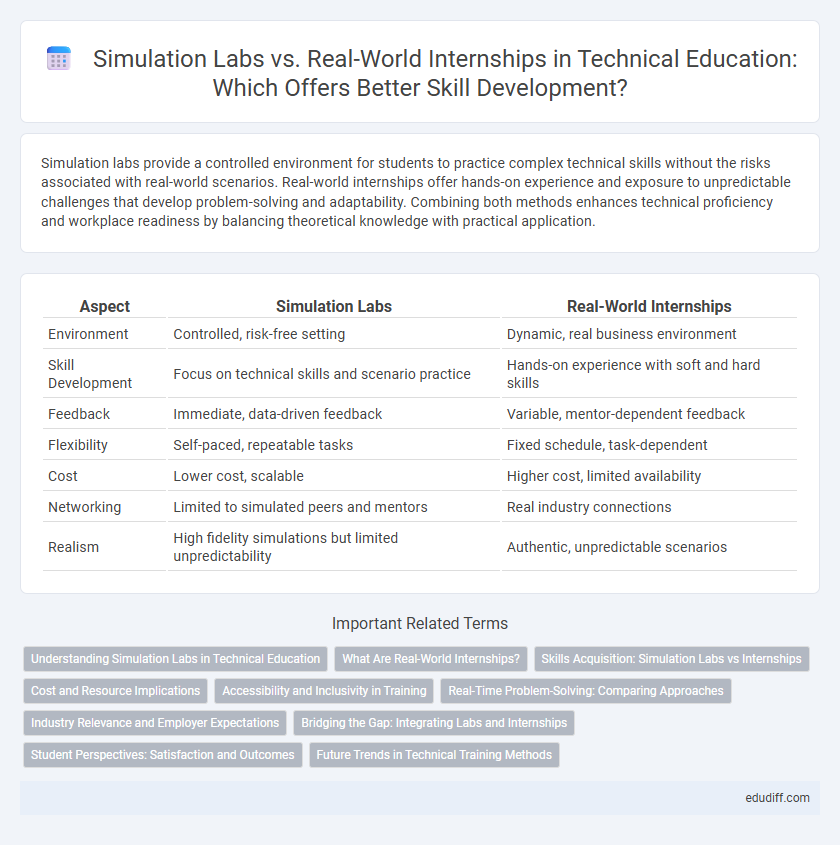Simulation labs provide a controlled environment for students to practice complex technical skills without the risks associated with real-world scenarios. Real-world internships offer hands-on experience and exposure to unpredictable challenges that develop problem-solving and adaptability. Combining both methods enhances technical proficiency and workplace readiness by balancing theoretical knowledge with practical application.
Table of Comparison
| Aspect | Simulation Labs | Real-World Internships |
|---|---|---|
| Environment | Controlled, risk-free setting | Dynamic, real business environment |
| Skill Development | Focus on technical skills and scenario practice | Hands-on experience with soft and hard skills |
| Feedback | Immediate, data-driven feedback | Variable, mentor-dependent feedback |
| Flexibility | Self-paced, repeatable tasks | Fixed schedule, task-dependent |
| Cost | Lower cost, scalable | Higher cost, limited availability |
| Networking | Limited to simulated peers and mentors | Real industry connections |
| Realism | High fidelity simulations but limited unpredictability | Authentic, unpredictable scenarios |
Understanding Simulation Labs in Technical Education
Simulation labs in technical education provide a controlled environment where students can practice complex procedures using virtual tools and realistic scenarios, enhancing skill acquisition without the risks associated with real-world errors. These labs leverage advanced software and hardware to replicate industry-specific challenges, enabling repetitive practice and immediate feedback critical for mastery in fields like engineering, healthcare, and information technology. Such immersive experiences complement theoretical knowledge, fostering deeper understanding and preparedness before entering real-world internships.
What Are Real-World Internships?
Real-world internships provide hands-on experience through work environments in actual industries, allowing students to apply theoretical knowledge to practical tasks and develop professional skills. These internships expose participants to real operational challenges, team dynamics, and organizational workflows often absent in simulation labs. Exposure to authentic workplace settings enhances problem-solving abilities and offers networking opportunities with industry professionals.
Skills Acquisition: Simulation Labs vs Internships
Simulation labs provide controlled environments that enable repetitive practice and mastery of technical skills, offering immediate feedback and error correction crucial for skill acquisition. Real-world internships expose learners to dynamic, unpredictable scenarios fostering adaptability, problem-solving, and interpersonal skills that simulations may lack. Combining simulation labs with internships maximizes technical proficiency and practical experience, accelerating comprehensive skill development in engineering and scientific fields.
Cost and Resource Implications
Simulation labs offer significant cost savings compared to real-world internships by eliminating expenses related to travel, accommodation, and site-specific safety measures. Resource allocation in simulation environments is more efficient, allowing multiple students to engage simultaneously without the need for on-site supervision or specialized equipment at different locations. While initial investment in advanced simulation technology can be high, long-term operational costs remain lower, providing scalable training solutions with reduced financial and logistical burdens.
Accessibility and Inclusivity in Training
Simulation labs provide accessible training environments that accommodate diverse learning needs, enabling participants with disabilities or geographic limitations to engage fully in skill development. Real-world internships often present barriers such as location constraints and physical accessibility, restricting opportunities for many individuals. By leveraging virtual simulations, training programs enhance inclusivity through customizable interfaces and scalable resources, ensuring equitable access for all learners.
Real-Time Problem-Solving: Comparing Approaches
Real-time problem-solving in simulation labs allows controlled, repeatable scenarios designed to develop specific skills without the risks of real-world consequences. Real-world internships expose students to unpredictable challenges, fostering adaptability and critical thinking through genuine industry experience. Both approaches cultivate problem-solving abilities but differ in experiential authenticity and situational complexity.
Industry Relevance and Employer Expectations
Simulation labs offer controlled environments that replicate industry scenarios, enhancing technical skills and decision-making processes essential for modern engineering and IT roles. Real-world internships provide direct exposure to dynamic workplace challenges, fostering adaptability and understanding of organizational culture, which aligns closely with employer expectations for practical experience. Employers prioritize candidates who demonstrate a blend of theoretical knowledge from simulation labs and hands-on problem-solving abilities acquired through real-world internships, ensuring readiness for industry demands.
Bridging the Gap: Integrating Labs and Internships
Simulation labs offer controlled environments for skill development, while real-world internships provide practical exposure to industry challenges. Integrating these approaches creates a comprehensive learning experience by allowing students to apply simulated concepts in actual workplace settings. This synergy enhances job readiness by bridging theoretical knowledge with hands-on application.
Student Perspectives: Satisfaction and Outcomes
Student perspectives indicate that simulation labs enhance skill acquisition by providing risk-free, repeatable practice environments, leading to increased confidence and competence. Real-world internships offer authentic exposure to workplace dynamics and professional networking, which are crucial for career readiness and employment opportunities. Surveys show a balanced integration of both methods yields the highest student satisfaction and improved post-internship outcomes.
Future Trends in Technical Training Methods
Simulation labs offer immersive, data-driven environments that enhance technical skill acquisition through realistic, repeatable scenarios, while real-world internships provide hands-on experience with unpredictable challenges and direct industry exposure. Advances in virtual reality (VR) and augmented reality (AR) technologies are driving the integration of simulation labs into technical training, enabling scalable, cost-effective learning with real-time performance analytics. Future trends emphasize a hybrid approach combining high-fidelity simulations and on-site internships to maximize competency development and workforce readiness in rapidly evolving technical fields.
Simulation Labs vs Real-World Internships Infographic

 edudiff.com
edudiff.com